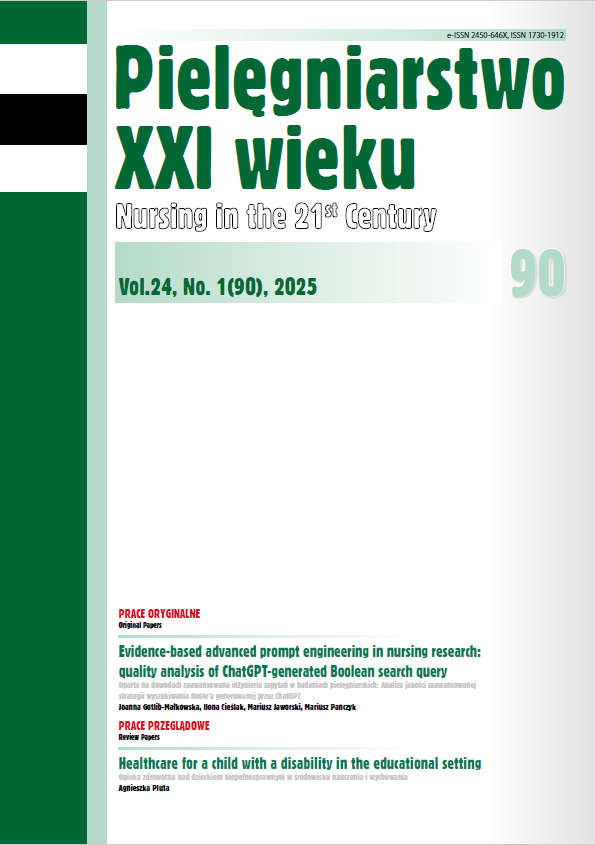Satisfaction with nursing care and the level of illness acceptance in surgical and non-surgical wards – a single-center study
DOI:
https://doi.org/10.12923/pielxxiw-2025-0005Keywords:
satisfaction, illness acceptance, Acceptance of Illness Scale, Newcastle Satisfaction with Nursing ScaleAbstract
Aim. to assess the correlation between patient satisfaction with nursing care in surgical and non-surgical departments in a university hospital and the level of illness acceptance.
Material and methods. We conducted the study using a diagnostic survey method with standardized questionnaires: the Newcastle satisfaction with nursing scales (NSNS) and the Acceptance of Illness Scale (AIS). We invited patients from three departments of the university hospital, hospitalized for at least 2 nights, to participate in the study. Out of 210 questionnaires provided, 121 (57.6%) were returned correctly completed. We performed statistical analysis using the IBM SPSS. We considered p≤0.05 values to be significant.
Results. The average AIS score was 24.2 points. The average Nursing care experiences score was 64.5, comparable in all groups. The average satisfaction score was 72.7. A statistically significant difference occurred between two departments – laryngology and neurology. Both aspects of the NSNS scale significantly positively correlated with level of disease acceptance (r=0.83, p<0.001, r=0.74; p<0.001).
Conclusions. Patient satisfaction depends on many individual factors, above all on the patient’s personal experiences and the level of illness acceptance. AIS was the strongest predictor of experiences and satisfaction, regardless of the department, hospitalization time, age, gender and education of the respondents.
References
1. Vladu A, Ghitea TC, Daina LG, et al. The evolution of patient satisfaction in postoperative care: the impact of investments and the algorithm for assessing significant growth over the last 5 years. Healthcare (Basel). 2024 Sep 12;12(18):1824. doi: 10.3390/healthcare12181824.
2. Zarzycka D, Bartoń E, Mazur A, et al. Socio-demographic and medical factors associated with patients’ satisfaction with nursing care and their perception of pain. Ann. Agric. Environ. Med. 2019 Jun 17;26(2):298-303. doi: 10.26444/aaem/90385.
3. Moczydłowska A, Krajewska-Kułak E, Bielski K, et al. Satysfakcja chorych z opieki medycznej. [w:] Krajewska-Kułak E, Łukaszuk C, Lewko J, et al. (red.). W drodze do brzegu życia. T. 11. Białystok: Uniwersytet Medyczny, Wydział Nauk o Zdrowiu; 2013, s.113-125.
4. Goodrich GW, Lazenby JM. Elements of patient satisfaction: An integrative review. Nurs. Open. 2023; 10(3): 1258-1269. doi: 10.1002/nop2.1437.
5. Seah A, Ng K, Ang T, et al. Patient perspectives regarding healthcare professional attire. Cureus. 2024; 16(3): e57157. doi: 10.7759/cureus.57157.
6. Barbosa CD, Balp MM, Kulich K, et al. A literature review to explore the link between treatment satisfaction and adherence, compliance, and persistence. Patient Prefer. Adherence. 2012; 6 :39-48. doi: 10.2147/PPA.S24752.
7. Gutysz-Wojnicka A, Dyk D, Cudak E, et al. Measuring patient satisfaction with the Polish version of the Newcastle Satisfaction with Nursing Scale. Scand. J. Caring. Sci. 2013;27(2):311-318. doi: 10.1111/j.1471-6712.2012.01034.x.
8. Moczydłowska A, Krajewska-Kułak E, Kózka M, et al. The expectations of patients towards nursing staff. Nursing Problems 2014; 22(4): 464-470.
9. Mahon PY. An analysis of the concept ‚patient satisfaction’ as it relates to contemporary nursing care. Journal of Advanced Nursing. 1996; 24(6): 1241-8. doi: 10.1111/J.1365-2648.1996.TB01031.X
10. Juczyński Z. Narzędzia pomiaru w promocji i psychologii zdrowia. Pracownia Testów Psychologicznych PTP. Warszawa; 2001.
11. Dyk D, Gutysz-Wojnicka A, Cudak EK, et al. Cultural adaptation and psychometric evaluation of the Polish version of the Newcastle Satisfaction with Nursing Scale. Arch. Med. Sci. 2014 Aug 29;10(4):782-790. doi: 10.5114/aoms.2014.44870.
12. Tomaszewska K, Majchrowicz B, Serwin A. Assessment of patient satisfaction with nursing care with the Newcastle scale. Nursing in the 21st Century. 2023; 1(82): 8-13. DOI: https://doi.org/10.2478/pielxxiw-2023-0002.
13. Hreńczuk M, Gorzała I, Małkowski P. The quality of nursing care provided in the neurosurgery department from the patients’ perspective. Surgical and Vascular Nursing 2022; 16(1): 23-30.
14. Hreńczuk M, Zielińska M, Małkowski P. Satisfaction with nursing care of patients after kidney transplantation. Nursing Problems. 2018; 26(4): 282-289. doi: 10.5114/ppiel.2018.84128.
15. Wierzbicka BK, Jankowska-Polańska B. Poziom jakości opieki pielęgniarskiej na przykładzie oddziałów Uniwersyteckiego Szpitala Kinicznego we Wrocławiu. Współczesne Pielęgniarstwo i Ochrona Zdrowia. 2014; 4: 91-96.
16. Sierpińska L, Dzirba A. The level of patient satisfaction with nursing care in hospital wards. Surgical and Vascular Nursing. 2011;5(1):18-22.
17. Borowska M, Religioni U, Augustynowicz A. Patients’ opinions on the quality of services in Hospital Wards in Poland. Int. J. Environ. Res. Public Health. 2022; 20(1): 412. doi: 10.3390/ijerph20010412.
18. Juszczak K, Jaracz K, Kuberka I. Subjective assessment of the quality of nursing care in terms of postoperative pain in patients undergoing surgical intervention. Surgical and Vascular Nursing. 2016; 10(4): 127-130.
19. Piotrkowska R, Terech-Skóra S, Mędrzycka-Dąbrowska W, et al. Factors determining acceptance of disease and its impact on satisfaction with life of patients with peripheral artery disease. Nurs Open. 2021; 8(3): 1417-1423. doi: 10.1002/nop2.758
20. Ścisło L, Bodys-Cupak I, Kózka M. Patient-centered care – analysis of the model and results of implementation in to the health care system. Sztuka Leczenia 2022; 1: 33-41 doi:10.4467/18982026SZL.22.004.15995.
Downloads
Published
Issue
Section
License
Copyright (c) 2025 Authors

This work is licensed under a Creative Commons Attribution 4.0 International License.




